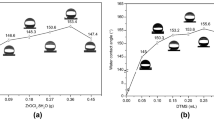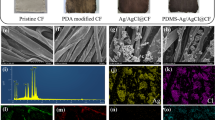Abstract
Surface science such as superhydrophobic and superoleophilic surfaces plays a sensitive function in a separating oil/water mixture as a result of increasing industrial oil and organic solvents drainage occurrence. In this work, copper hydroxide nanoneedles layer were synthesized onto Egyptian cotton fabrics (CF) treated with polydopamine, Ag nanoparticles (NPs) and Cu NPs via facile immersion process. Fourier transform infrared, X-ray diffraction and scanning electron microscope (SEM) were used to investigate the functionalized surface of CF with copper hydroxide layer. SEM images confirmed that the modified membranes were rougher compared with pure surface of CF. The contact angle measurement emphasized the hydrophobicity of the modified membranes and it was found that the water contact angle has a value of 168°. The absorption capacity of the modified CF membrane was 10.1 g g − 1 for diesel oil and the separation efficiency of this modified surface was higher than 99%. It was noted that the flux in the case of low viscosity solvent as n-hexane was 72,172.9 Lm− 2 h− 1, while for the viscous oil as diesel was 14,460.3 Lm− 2 h− 1.
Graphic abstract













Similar content being viewed by others
References
Abou-Okeil A (2012) Ag nanoparticles growing onto cotton fabric using chitosan as a template. J Nat Fibers 9:2
Ali F, Khan SB, Kamal T, Alamry KA, Asiri AM, Sobahi TRA (2017) Chitosan coated cotton cloth supported zero-valent nanoparticles:sSimple but economically viable, efficient and easily retrievable catalysts. Sci Rep 7:A.N 16957
Arumugham T, Kaleekkal NJ, Rana D, Doraiswamy M (2016) Separation of oil/water emulsions using nano MgO anchored hybrid ultrafiltration membranes for environmental abatement. J Appl Polym Sci 133:42848
Ashaghi KS, Ebrahimi M, Czermak P (2007) Ceramic ultra- and nanofiltration membranes for oil field produced water treatment: a mini review. Open Environ Sci 1:1–8
Bai X, Xue CH, Jia ST (2016) Surfaces with sustainable Superhydrophobicity upon mechanical abrasion. ACS Appl Mater Interfaces 8:28171–28179
Bayat A, Aghamiri SF, Moheb A, Vakili-Nezhaad GR (2005) Oil spill cleanup from sea water by sorbent materials. Chem Eng Technol 28:12
Cheng Q-Y, An X-P, Li Y-D, Huang C-L, Zeng J-Bl (2017) Sustainable and biodegradable superhydrophobic coating from epoxidized soybean Oil and ZnO nanoparticles on cellulosic substrates for efficient Oil/Water separation. ACS Sustainable Chem Eng 5:11440–11450
Chang TL, Liu T, Liang J (2018) The dataset of scanning electron microscope images of Silver nanoparticles formed in situ by dopamine chemistry. Data in Brief 20:090–1092
Chen X, Weibel JA, Garimella SV (2016) Continuous oil–water separation using polydimethylsiloxane-functionalized melamine sponge. Ind Eng Chem Res 55:3596–3602
Cheng Q-Y, Guan C-S, Wang M, Li Y-D, Zeng J-B (2018) Cellulose nanocrystal coated cotton fabric with Superhydrophobicity for Efficient Oil/Water separation. carbophydr polym 199:390–396
Cheng Q-Y, Zhao X-L, Weng Y-X, Li Y-D, Zeng J-B (2019) Fully sustainable, nanoparticle-free, fluorine-free, and robust Superhydrophobic cotton fabric fabricated via an eco-friendly method for efficient Oil/Water separation. ACS Sustainable Chem Eng 7:15696–15705
Daiminger U, Nitsch W, Plucinski P, Hoffmann S (1995) Novel techniques for oil/water separation. J Membr Sci 99:197–203
Fan T, Qian Q, Hou Z, Liu Y, Lu M (2018) Preparation of smart and reversible wettability cellulose fabrics for oil/water separation using a facile and economical method. Carbohydr Polym 200:63–71
French AD (2014) Idealized powder diffraction patterns for cellulose polymorphs. Cellulose 21:885–896
Feng L, Li S, Li Y, Li H, Zhang L, Zhai J, Song Y, Liu B, Jiang L, Zhu D (2002) Super-hydrophobic surfaces; from natural to artificial. Adv Mater 24:14–20
Gao D, Wang L, Wang C, Chen T (2019) Photocatalytic self-cleaning cotton fabrics coated by Cu2(OH)PO4 under VIS/NIR irradiation. Material 12:238
Grouchko M, Kamyshny A, Ben-Ami K, Magdassi S (2009) Synthesis of copper nanoparticles catalyzed by pre-formed silver nanoparticles. J Nanopart Res 11:713–716
Gupta VK, Carrott PJM, Carrott R, Suhas MML (2009) Low-cost adsorbents: growing approach to wastewater treatment—A review. Environ Sci Technol 39:783–842
Gupta RK, Dunderdale GJ, England MW, Hozumi A (2017) Oil/water separation techniques: a review of recent progresses and future directions. J Mater Chem A 5:16025–16058
Guan Y, Cheng F, Pan Z (2019) Superwetting polymeric three dimensional (3D) porous materials for oil/water separation: a review. Polymer 11:806–820
Hu J, Wu S, Cao Q, Zhang W (2016) Synthesis of core-shell structured alumina/Cu microspheres with the activation of silver nanoparticles deposited on polydopamine-coated surfaces. RSC Adv 6:81767–81773
Jauregui KMG, Pineda MG, Salinas JER, Hurtado G, Saade H, Martinez JL, Ilyina A, L´opez RG (2012) One-step method for preparation of magnetic nanoparticles coated with chitosan. J Nanomater 0–8
Liu Z, Qin D, Zhao J, Feng Q, Li Z, Bai H, Sun DD (2019) Efficient oil/water separation membrane derived from super-flexible and superhydrophilic core–shell organic/inorganic nanofibrous architectures. Polymers 11:974–980
Liu G, Jin W, Xu N (2016) Two-dimensional-material membranes: a new family of high-performance separation membranes. Angew Chem Int Ed 55:13384–13397
La DD, Thi HPN, Kim YS, Rananaware A, Bhosale SV (2017) Facile fabrication of Cu II)-porphyrin MOF thin films from tetra kis(4-carboxyphenyl) Porphyrin and Cu (OH)2 nanoneedle array. Appl Surf Sci 424:145–150
Li S, Huang J, Ge M, Cao C, Deng S, Zhang S, Chen G, Zhang K, Al-Deyab SS, Lai YK (2015) Robust flower-like TiO2 @cotton fabrics with special wettability for fffective self-cleaning and versatile oil/water separation. Adv Mater Interfaces 2:1500220
Liu Y, Peng Y, Zhang T, Qiu F, Yuan D (2018) Superhydrophobic, ultralight and flexible biomass carbon aerogels derived from sisal fibers for highly efficient oil–water separation. Cellulose 25:3067–3078
Lu C, Qi L, Yang J, Zhang D, Wu N, Ma J (2004) Simple template-free solution route for the controlled synthesis of Cu(OH)2 and CuO nanostructures. J Phys Chem B 108:17825–17831
Luo H, Gu C, Zheng W, Dai F, Wanga X, Zheng Z (2015) Facile synthesis of novel size-controlled antibacterial hybrid spheres using silver nanoparticles loaded with poly-dopamine spheres. RSC Adv 5:13470–13477
Ma Y, Niu H, Zhangab X, Cai Y (2011) One-step synthesis of silver/dopamine nanoparticles and visual detection of melamine in raw milk. RSC Analyst 136:4192–4196
Munirasu S, Haija MA, Banat F (2016) Use of membrane technology for oil field and refinery produced water treatment—A review. Process Saf Environ Prot 100:183
Naseem S, Wu C-M, Xu T-Z, Lai C-C, Rwei S-P (2018) Oil-water separation of electrospun cellulose triacetate nanofiber membranes modified by electrophoretically deposited TiO2/graphene oxide. Polymers 10:746–755
Portella EH, Romanzini D, Angrizani CC, Amicob SC, Zatteraa AJ (2016) Influence of stacking sequence on the mechanical and dynamic mechanical properties of cotton/glass fiber reinforced polyester composites. J Mater Res 19:542–547
Pramanik A, Maiti S, Mahanty S (2015) Reduced Graphene Oxide Anchored Cu (OH)2 as High-Performance Electrochemical Supercapacitor. RSC Dalton Trans 44:14604–14612 ()
Rajakovic V, Aleksic G, Radetic M, Rajakovic L (2007) Efficiency of Oil Removal from Real Wastewater with Different Sorbent Materials. J Hazard Mater 143:494–499
Sedighi A, Montazer M, Hemmatinejad N (2014) Copper Nanoparticles on Bleached Cotton Fabric: in situ Synthesis and Characterization. Cellulose 21:3–10
Si YF, Guo ZG, Liu WM (2016) A Robust Epoxy Resins @ Stearic Acid-Mg (OH)2 Micro-nanosheet Superhydrophobic Omnipotent Protective Coating for Real Life Applications. ACS Appl Mater Interfaces 8:16511–16520 ()
Wang H, Hu X, Ke Z, Du CZ, Zheng L, Wang C, Yuan Z (2018) Review: Porous Metal Filters and Membranes for Oil–Water Separation. Nanoscale Res Lett 13:284–290
Wu X, Shi G (2006) Production and Characterization of Stable Superhydrophobic Surfaces Based on Copper Hydroxide Nanoneedles Mimicking the Legs of Water Striders. J Phys Chem B 110:11247–11252 ()
Wang G, He Y, Wang H, Zhang L, Yu QY, Peng SS, Wu XD, Ren TH, Zeng ZX, Xu QJ (2015) A cellulose sponge with robust superhydrophilicity and under-water superoleophobicity for highly effective oil/water separation. Green Chem 17:3093–3099
Wei Y, Qi H, Gong X, Zhao S (2018) Specially wettable membranes for oil–water separation. Adv Mater Interfaces 5:1800576
Wang B, Liang W, Guo Z, Liu W (2015) Biomimetic super-lyophobic and super-lyophilic materials applied for oil/water separation: a new strategy beyond nature. Chem Soc Rev 44:336–345
Xu Q, Kong Q, Liu Z, Zhang J, Wang X, Liu R, Yuea L, Cui G (2014) Polydopamine-coated cellulose micro fibrillated membrane as high-performance lithium-ion battery separator. RSC Adv 4:7845–7850
Xu CL, Wang YZ (2017) One-step approach to the growth of ZnO nano-/ microrods on cellulose toward its durable superhydrophobicity. Adv Mater Interfaces 1700550
Xu CL, Wang YZ (2018) Self-assembly of stearic acid into nano flowers induces the tunable surface wettability of polyimide film. Mater Des 138:30–38
Xua Z, Hori KMT (2016) Fabrication of polydopamine-coated superhydrophobic fabrics for oil/water separation and self-cleaning. Appl Surf Sci 370:243–251
Yazhini KB, Prabu HG (2015) Study on flame retardant and UV protection properties of cotton fabric functionalized with ppy-ZnO-CNT nanocomposite. RSC Adv 5:49062–49069
Yong J, Huo J, Chen F, Yang Q, Hou X (2018) Oil/water separation based on the natural materials with super-wettability: recent advances. Phys Chem Chem Phys 20:25140–25163
Yong JL, Chen F, Yang Q, Bian H, Du GQ, Shan C, Huo JL, Fang Y, Hou X (2016) Oil-water separation: a gift from the desert. Adv Mater Interfaces 3:1500650
Zhang YX, Huang M, Li F, Wen ZQ (2013) Controlled synthesis of hierarchical CuO nanostructures for electrochemical capacitor electrodes. Int J Electrochem Sci 8:8645–8661
Zhang WF, Liu N, Cao YZ, Lin X, Liu YN, Feng L (2017) Superwetting porous materials for wastewater treatment: from immiscible oil/water mixture to emulsion separation. Adv Mater Interfaces 4:1700029
Author information
Authors and Affiliations
Corresponding author
Additional information
Publisher's Note
Springer Nature remains neutral with regard to jurisdictional claims in published maps and institutional affiliations.
Rights and permissions
About this article
Cite this article
Belal, A.S., Khalil, M.M.A., Soliman, M. et al. Novel superhydrophobic surface of cotton fabrics for removing oil or organic solvents from contaminated water. Cellulose 27, 7703–7719 (2020). https://doi.org/10.1007/s10570-020-03316-1
Received:
Accepted:
Published:
Issue Date:
DOI: https://doi.org/10.1007/s10570-020-03316-1




